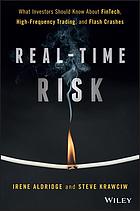دانلود کتاب Real-time risk : what investors should know about FinTech, high-frequency trading, and flash crashes - Original PDF
Author:
Joe Duarte
0 (0)
توضیحات کتاب :
Abstract: Risk management solutions for today's high-speed investing environment Real-Time Risk is the first book to show regular, institutional, and quantitative investors how to navigate intraday threats and stay on-course. The FinTech revolution has brought massive changes to the way investing is done. Trading happens in microsecond time frames, and while risks are emerging faster and in greater volume than ever before, traditional risk management approaches are too slow to be relevant. This book describes market microstructure and modern risks, and presents a new way of thinking about risk management in today's high-speed world. Accessible, straightforward explanations shed light on little-understood topics, and expert guidance helps investors protect themselves from new threats. The discussion dissects FinTech innovation to highlight the ongoing disruption, and to establish a toolkit of approaches for analyzing flash crashes, aggressive high frequency trading, and other specific aspects of the market. Today's investors face an environment in which computers and infrastructure merge, regulations allow dozens of exchanges to coexist, and globalized business facilitates round-the-clock deals. This book shows you how to navigate today's investing environment safely and profitably, with the latest in risk-management thinking. -Discover risk management that works within micro-second trading -Understand the nature and impact of real-time risk, and how to protect yourself -Learn why flash crashes happen, and how to mitigate damage in advance -Examine the FinTech disruption to established business models and practices When technology collided with investing, the boom created stratospheric amounts of data that allows us to plumb untapped depths and discover solutions that were unimaginable 20 years ago. Real-Time Risk describes these solutions, and provides practical guidance for today's savvy investor
سرچ در وردکت | سرچ در گودریدز | سرچ در اب بوکز | سرچ در آمازون | سرچ در گوگل بوک
1,098 بازدید 0 خرید










